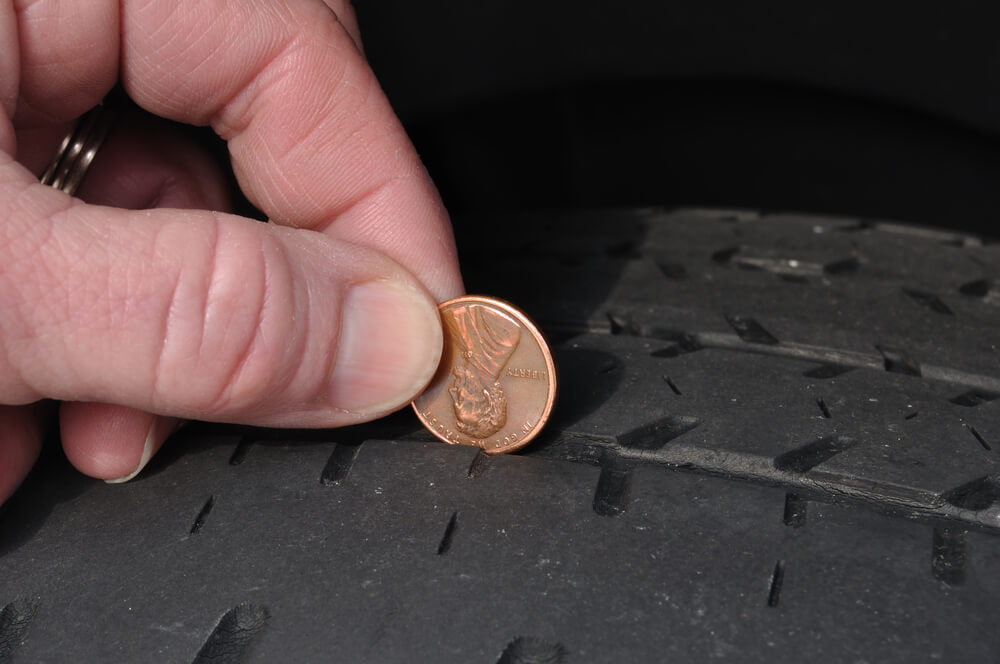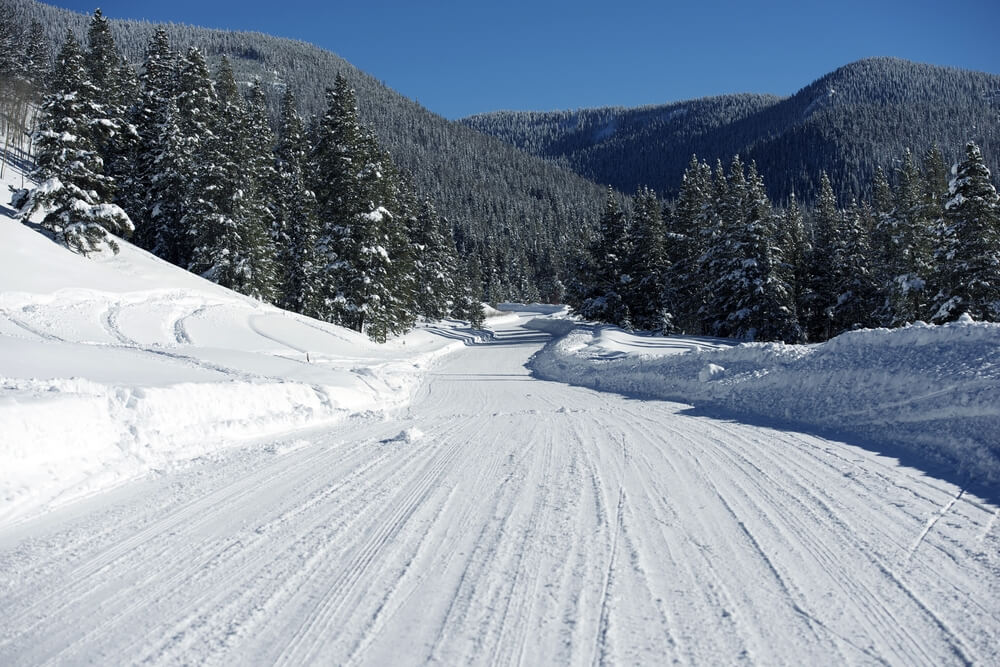victims for over 25 years.
Do I Need Chains to Drive in Colorado During the Winter?
After an unseasonably rainy spring and a hot summer in Colorado, we’re now turning the corner into fall. There’s a tree on my block that always changes colors first, winning every year with a bright display of red leaves before any other tree even changes one leaf. I see that tree’s wardrobe change and my mind turns to winter in Colorado!
Of course, with snowfall comes winter driving in Colorado, which can be intimidating. So, before the first storm hits, I thought I’d share some tips and rules about using chains and snow tires in Colorado.
Check Your Tires for Winter Driving in Colorado

Checking your tire tread before driving in Colorado’s winter conditions is essential for your safety and the safety of others on the road. Winters in Colorado can bring icy roads, heavy snowfall, and unpredictable weather, making it crucial to ensure your tires are up to the task. Here are some acceptable ways to check your tire tread before heading out in winter:
- Tread Depth Measurement: Use a tread depth gauge or the penny test to check the depth of your tire tread. The minimum legal tread depth is typically 2/32 of an inch, but for winter driving in Colorado, it’s advisable to have at least 4/32 of an inch or more for better traction. To perform the penny test, insert a penny into your tire’s tread with Lincoln’s head facing down. If you can see the top of Lincoln’s head, it’s time to replace your tires.
- Visual Inspection: Inspect your tires for signs of uneven wear or damage. Look for cuts, bulges, cracks, or foreign objects embedded in the tread. Uneven wear may indicate alignment or suspension issues that should be addressed before winter driving.
- Tire Pressure: Ensure your tires are properly inflated according to the manufacturer’s recommendations, as tire pressure can significantly affect traction and handling on slippery roads. Cold temperatures can cause tire pressure to drop, so check it regularly throughout the winter.
- Snow Tires or Chains: In Colorado’s mountainous regions, it’s often advisable to use dedicated snow tires or carry chains in your vehicle. (See the next section of this article for more in-depth information.) Snow tires are designed with deeper treads and softer rubber compounds to provide better traction in winter conditions.
- Consult an Expert: If you’re unsure about your tires’ condition or suitability for winter driving in Colorado, seek advice from a certified tire professional. They can assess your tires and recommend the best course of action, whether it’s replacing worn tires or choosing the right type of tires for the season.
- Rotate and Balance: Regularly rotating and balancing your tires can help ensure even wear and better performance during winter months. This maintenance can extend the lifespan of your tires and improve their winter grip.
- Tire Chains: Familiarize yourself with how to install tire chains if you plan to drive in areas with chain requirements during winter storms. Practice installing them before you need them to ensure you can do it quickly and safely when conditions worsen.
Taking the time to check your tire tread and maintain your tires properly can make a significant difference in your safety when driving in Colorado’s challenging winter weather. Don’t overlook this essential aspect of winter preparedness.
To Chain or Not to Chain in Colorado

A lot of people think that only the big commercial trucks must have chains available for winter driving in Colorado. Not so. There are actually winter tire requirements for all vehicles traveling on I-70 between mile point 259 (Morrison) and mile point 133 (Dotsero). Depending on your car and your tires, you might be required to have chains.
The standards are based on the weight of your vehicle, and whether it’s two- or four-wheel drive.
Requirements for two-wheel-drive motor vehicles
All two-wheel drive motor vehicles weighing less than 16,001 pounds (even a compact truck averages 5,000-5,500 pounds) traveling on any portion of I-70 between mile point 259 (Morrison) and mile point 133 (Dotsero) from September 1st through May 31st must have:
- Tire chains for two or more drive tires; OR
- An approved alternative traction device for two or more drive tires; OR
- Tires with a tread depth of at least 3/16-inch and which are rated for either “All weather” or “Mud and Snow” (indicated by an “All Season”, M+S, M/S, etc. on sidewall) by the manufacturer.
Requirements for four-wheel drive motor vehicles
All four-wheel drive motor vehicles weighing less than 16,001 pounds traveling on any portion of I-70 between mile point 259 (Morrison) and mile point 133 (Dotsero) from September 1st through May 31st must have tires with a tread depth of at least 3/16-inch and are adequate for winter driving conditions.
A Few More Colorado Winter Driving Tips

Of course, your tires are just your contact point with the ground. Since you aren’t in control of everybody else on the road, you need to be prepared for an emergency, even if you have the world’s best snow tires. Here are a few more things to consider before the first big snow hits this winter.
- Pack an Emergency Kit: Be ready for unexpected situations by packing an emergency kit. Include blankets, extra gloves, a flashlight, non-perishable snacks, a small shovel, and a fully charged phone with a car charger. Stay connected and prepared for any roadside emergencies.
- Check Your Vehicle’s Condition: Regular vehicle maintenance is key. Before winter sets in, check your brakes, battery, heater, and defroster to prevent unexpected breakdowns on cold mountain roads.
- Slow Down and Increase Following Distance: Safety comes first. Reduce your speed and maintain a safe distance between vehicles. The unpredictable nature of winter weather demands extra caution.
- Know How to Use Four-Wheel Drive: If your vehicle has four-wheel drive, familiarize yourself with how to use it effectively. Engage it before encountering slippery conditions, and practice using it in a controlled environment.
- Keep an Eye on the Weather Forecast: Stay informed about changing weather conditions and road status by regularly checking local forecasts and road condition updates. Adjust your travel plans as necessary to ensure a safe journey.
- Plan Ahead: Plan your routes carefully, especially if you’re not familiar with Colorado’s winter driving challenges. Avoid steep or winding roads when possible and choose well-maintained highways and alternate routes for a safer journey.
As you embark on your winter drive through the picturesque landscapes of Colorado, remember that preparation and caution are your best companions. With these tips in mind, you can fully enjoy the beauty and wonder that Colorado’s winter season has to offer while ensuring your safety on the road. Drive safely, and embrace the magic of a Colorado winter! And as always, please reach out to us if you or a loved ones needs help after a car accident.
Free Consultation
Search For
Recent Articles
- Are all motorcycles created equal?
- Frequently Asked Questions about Personal Injury Attorneys
- How Do Personal Injury Attorneys Calculate Future Medical Expenses in a Car Crash Settlement?
- Ways to Increase Your Visibility When Riding Your Bicycle in Denver
- 5 Reasons to Hire a Personal Injury Attorney if a Loved One Is Injured
Categories
- Arvada
- Aurora
- Auto Accident eBook
- Auto Insurance
- Bicycle
- Bicycle/Motorcycle Accidents
- Bodily injury
- Car accidents
- Centennial
- Colorado
- Colorado Legislature
- community
- Concussion
- Denver
- distracted driving
- DUI Accidents
- Englewood
- Events
- Flood Insurance
- Fort Collins
- Highlands Ranch
- Hit and Run
- In The News
- insurance companies
- Lakewood
- Littleton
- Marijuana DUI
- Motorcycle Accidents
- Motorcycle Insurance
- Motorcycle Law eBook
- Motorcycles
- Newsletter
- Pedestrian
- Personal Injury Law
- Safe Driving
- Safety
- Scooters
- technology
- Thornton
- Tips
- Uncategorized
- vibrio vulnificus bacteria
- Videos
- Westminster
- Winter Driving
Archive
- March 2024
- February 2024
- January 2024
- December 2023
- November 2023
- October 2023
- September 2023
- August 2023
- July 2023
- June 2023
- May 2023
- April 2023
- March 2023
- February 2023
- January 2023
- November 2022
- September 2022
- April 2022
- March 2022
- February 2022
- January 2022
- December 2021
- November 2021
- October 2021
- September 2021
- August 2021
- July 2021
- June 2021
- May 2021
- April 2021
- January 2021
- December 2020
- November 2020
- October 2020
- September 2020
- August 2020
- July 2020
- June 2020
- May 2020
- April 2020
- March 2020
- February 2020
- January 2020
- December 2019
- November 2019
- October 2019
- September 2019
- August 2019
- July 2019
- June 2019
- May 2019
- March 2019
- February 2019
- January 2019
- December 2018
- November 2018
- October 2018
- September 2018
- August 2018
- July 2018
- June 2018
- May 2018
- April 2018
- March 2018
- February 2018
- January 2018
- December 2017
- November 2017
- October 2017
- September 2017
- August 2017
- July 2017
- June 2017
- May 2017
- April 2017
- March 2017
- February 2017
- January 2017
- December 2016
- November 2016
- October 2016
- September 2016
- August 2016
- July 2016
- June 2016
- May 2016
- April 2016
- March 2016
- February 2016
- January 2016
- December 2015
- November 2015
- October 2015
- September 2015
- August 2015
- July 2015
- June 2015
- May 2015
- April 2015
- February 2015
- December 2014
- November 2014
- October 2014
- September 2014
- July 2014
- June 2014
- May 2014
- April 2014
- March 2014
- February 2014
- January 2014
- October 2013
- October 2012
- September 2012
- August 2012
- July 2012
- February 2012
- August 2011
- March 2011
- October 2010